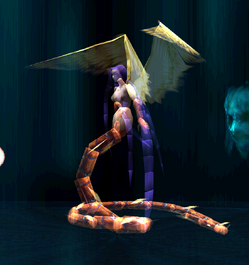| This article pertains to Xenogears: the sub-database of Xenosaga Wiki. |

Urobolus is the final boss of Xenogears, taking place after defeating Deus and its counterparts.
History
Karellen, wishing to know the true nature of human kind, puts Fei Fong Wong through one final test, this time against a form of Myyah as the 'Urobolus'. In this form, she is half human and half serpent, with angelic wings. Fei fights her in Xenogears. The music that plays is "One who Bares Fangs at God".
Once Urobolus is defeated, Karellen understands this meaning of love between Fei and Elly, as well as humanity itself, something Sophia had tried to teach him long ago. Karellen then allows Fei and Elly to return to their planet to live their lives with their friends. Although Karellen envies Fei and Elly, he continues his path into the Wave Existence to walk with God.
Urobolus Ring
| “ | And...yes, the Urobolus Ring...! That is it, isn't it...? Miang, and Lacan's actions... This explains everything. Elhaym... You were the 'mother'....
|
” |
Hidden in Elehayym's genetic code is an Urobolos Ring, specifically her introns. When this ring is connected, Elly is in a nonawakened state. When it is severed, Elly awakens as Myyah.[1]
Perfect Works uses the Urobolus Ring to symbolize Myyah and Elehayym's similarities and contrasts in relation to the growth of the Contact's (and humanity's) ego. Myyah as the archetype of the "Great Mother", who prevents their child from properly developing their ego, thus becoming aware enough to break the cycle, while Elehayym is the opposite of this, witnessing and guiding the Contact's self-growth.[1]
Myyah's role as the "Great Mother" extends to civilizations, as well. When a civilization's 'ego' develops too much, they become an obstacle for Myyah's goals, and are eradicated.
Etymology
Urobolus is a misspelling of Ouroboros or Uroborus, a symbol of a snake eating its own tail. Derived from the Ancient Greek word οὐροβόρος, meaning "tail eating", it is used to symbolize an endless cycle of death and rebirth, and was used in ancient Greek magical tradition and Egyptian iconography. It later became used in Gnostic and Hermetic circles, notably in regards to alchemy.[2]
Trivia
- An interview revealed that both Deus and Urobolus are symbolic of the demiurge, often depicted as a snake.[citation needed]
- Her figure may draw inspiration to Lilith from Jewish folklore, who is depicted as Adam's first wife. Sometimes portrayed as a half-woman half-snake being, she is often compared to a succubus and the mother of all demons.
- The ouroboros is present in Xenosaga as the logo for the U.M.N.
- The Ouroboros is a central part of the story and world of Xenoblade Chronicles 3 and its DLC expansion, Future Redeemed.
- Urobolus's role as an extremely easy final boss after a very difficult penultimate boss fight is similar to Albedo Piazzolla's final boss fight in Xenosaga Episode II: Jenseits von Gut und Böse and Yu Yevon in Final Fantasy X.

